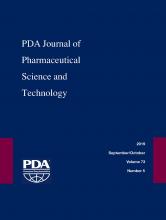Abstract
Dilution of samples with water (water dilution method) was not appropriate for measuring the endotoxin activity in solutions containing chelating agents and detergents—typical formulations showing low endotoxin recovery (LER). Dilution of the samples with 2 mM magnesium solution (magnesium dilution method) or addition of the samples directly to the Limulus amebocyte lysate (direct method) provided accurate endotoxin activity values in the samples. The difference between the water dilution method and the magnesium dilution method/direct method seemed to be caused by an endotoxin activity decrease during the water dilution method. Endotoxin activity was maintained for more than a month in LER solutions kept at 4°C when the activity was measured by the magnesium dilution method or the direct method. The magnesium concentration in the diluent for the magnesium dilution method should be greater than the concentration of the chelating agent in the sample. Magnesium dilution is the most appropriate dilution method for endotoxin measurement in LER solutions. LER effects were stronger in solutions with sodium citrate and polysorbate 20 than in solutions with phosphate buffer and polysorbate 80, respectively. Human serum albumin was also found to be an LER mitigating factor, and this suggests that protein might reduce LER effects.
LAY ABSTRACT: Low endotoxin recovery (LER) is a phenomenon in which detectable endotoxin activity is reduced by biopharmaceutical product formulations containing a chelating agent and a detergent. The bacterial endotoxins test (BET) is a safety test used to detect endotoxin contamination of parenteral drugs and medical devices. Dilution of the samples with water is the most common method used to overcome interference by the samples with the BET. This study demonstrates that the water dilution method was not appropriate for measuring endotoxin activity in samples showing LER, and that the magnesium dilution method was the most appropriate method for this purpose. This study shows the conditions for the magnesium dilution method and some LER mitigating factors.
- Endotoxin
- Limulus amebocyte lysate
- Low endotoxin recovery (LER)
- Lipopolysaccharide
- Bacterial endotoxins test
- Magnesium dilution
- © PDA, Inc. 2019
PDA members receive access to all articles published in the current year and previous volume year. Institutional subscribers received access to all content. Log in below to receive access to this article if you are either of these.
If you are neither or you are a PDA member trying to access an article outside of your membership license, then you must purchase access to this article (below). If you do not have a username or password for JPST, you will be required to create an account prior to purchasing.
Full issue PDFs are for PDA members only.
Note to pda.org users
The PDA and PDA bookstore websites (www.pda.org and www.pda.org/bookstore) are separate websites from the PDA JPST website. When you first join PDA, your initial UserID and Password are sent to HighWirePress to create your PDA JPST account. Subsequent UserrID and Password changes required at the PDA websites will not pass on to PDA JPST and vice versa. If you forget your PDA JPST UserID and/or Password, you can request help to retrieve UserID and reset Password below.






